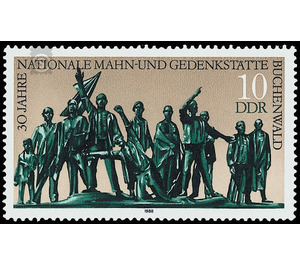Commemorative stamp series - Germany / German Democratic Republic 1988 - 10 Pfennig
Theme: Architecture
| Country | Germany / German Democratic Republic |
| Issue Date | 1988 |
| Face Value | 10.00 |
| Color | brown green |
| Perforation | K 14 |
| Printing Type | Rotogravure 2 |
| Stamp Type | Postage stamp |
| Item Type | Stamp |
| Chronological Issue Number | 2939 |
| Chronological Chapter | GER-DDR |
| SID | 590742 |
| In 20 Wishlists | |
30 years National Memorial and Memorial Buchenwald The Ministry of Posts and Telecommunications of the German Democratic Republic issues a multicolored special postage stamp "30 years National Memorial and Memorial Buchenwald". No Special First Day Cover Cover Special cancellation from 13th September to 12th November 1988 30th Anniversary of the Buchenwald National Remembrance and Memorial Center "0 Buchenwald, I can not forget you ..." begins the refrain of the Buchenwald song written by the inmates on Ettersberg near Weimar sang - once the Buchenwald hiking destination of the great German poet Johann Wolfgang von Goethe. Fascist concentration camp from July 1937 to the day of liberation of the prisoners on April 11, 1945. In it, people from 35 nations were harassed, humiliated, murdered. More than 6,500 inmates have been killed in this concentration camp and its satellite camps, as well as in various commandos. A balance of horror and horror. On the day of their self-liberation, 21,000 prisoners were still alive, unbroken and unanimous in their will: never again fascism, never war again! On September 14, 1958, the national memorial and memorial Buchenwald was inaugurated. In tens of thousands of voluntary working hours and with 12 million marks in donations, the population of the GDR supported the creation of this memorial. It includes the former concentration camp with its current museum facilities and the Memorial Road Memorial, the Road of Nations, the Ringgruber, the Freedom Street, the monument group and the bell tower. On his doors are the obligatory words from the oath of the survivors: "The destruction of Nazism with its roots is our slogan, the construction of a new world of peace and freedom our goal." The monument group created by Prof. Fritz Cremer from the GDR, looking from the Ettersberg into the Thuringian countryside, consists of eleven bronze figures in average size of 3.5 meters. They differ in gesture and attitude from each other and are still connected. A fighter puts his right hand protectively on the boy's shoulder, from whose face everything childlike has left. He wants to fight. trusting the adults, he follows with them the "swearing one", the source of strength for the ensemble. He strengthens and encourages the resolute, he calls and reaches the seekers, supports the weak, admonishes the desperate and unbelievers. The "swearing one" speaks the words in the name of his fellow combatants, also of the "falling". His outstretched oath hand is, as it were, the continuation of the upturned arms of the collapsing comrade. This attitude symbolizes continuing the fight on his behalf in order to fulfill the dying person's legacy. To the left and right of the "swearing" are two inmates each with the worker's flag and the rifle or cap and one wrapped in a blanket, tensing up the forces and determined not to give way. Another figure of the group raises his right arm calling him, while he extends his left hand to the outstretched group, asking for help and solicitation in one significant. Behind him is the "discussant", it seems that he does not understand what the caller says, but he hopes for an answer and clarification. The outstretched hand of the "caller" is aimed at the "doubter", who, not understanding the event, is shown old and emaciated. From the sufferings in the camp his will and his fighting power are broken, indicated by his limp and helplessly hanging down arms. The "negative" deliberately excludes. Standing heavy and straddled, his hands in his coat pockets, his mouth a little mockingly warped. Unbelief turns his face into a mask. Asked by resistance fighters, Fritz Cremer, why he included these two figures in his ensemble, since they would not have contributed to the self-liberation and the struggle of the prisoners, replied: "I wanted to make it clear that the bravest and the victory over the barbarism convinced themselves Inmates had to deal not only with their tormentors, the SS, but also with the mass of resigned camp inmates who, as they were, embodied the contradictions and conflicts of the struggle, but to overcome them made him more difficult, but at the same time greater in victory Doubters and negatives belong to the truth of Buchenwald - as to the truth of life in general - that develops in conflicts and contradictions. "


